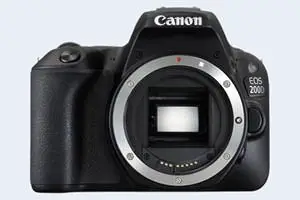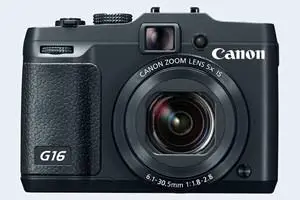Canon 200D vs G16
The Canon EOS 200D (called Canon SL2 in some regions) and the Canon PowerShot G16 are two digital cameras that were revealed to the public, respectively, in June 2017 and August 2013. The 200D is a DSLR, while the G16 is a fixed lens compact. The cameras are based on an APS-C (200D) and a 1/1.7-inch (G16) sensor. The 200D has a resolution of 24 megapixels, whereas the G16 provides 12 MP.
Below is an overview of the main specs of the two cameras as a starting point for the comparison.

Check 200D offers at
ebay.com

Check G16 offers at
ebay.com
Going beyond this snapshot of core features and characteristics, what are the differences between the Canon EOS 200D and the Canon PowerShot G16? Which one should you buy? Read on to find out how these two cameras compare with respect to their body size, their imaging sensors, their shooting features, their input-output connections, and their reception by expert reviewers.
Body comparison
The side-by-side display below illustrates the physical size and weight of the Canon 200D and the Canon G16. The two cameras are presented according to their relative size. Three successive views from the front, the top, and the rear are shown. All size dimensions are rounded to the nearest millimeter.
The 200D can be obtained in two different colors (black, white), while the G16 is only available in black.
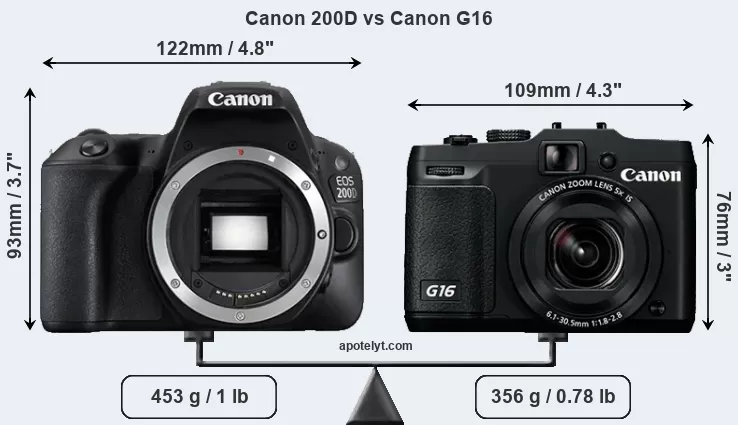
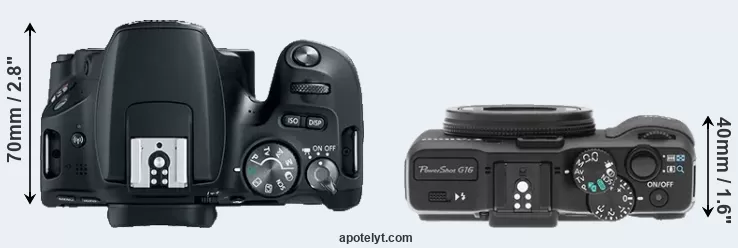
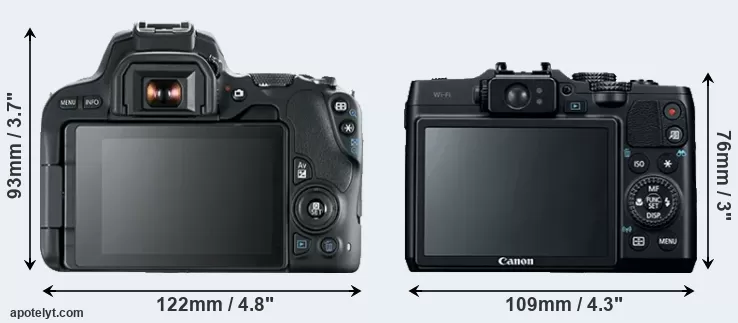
If the front view area (width x height) of the cameras is taken as an aggregate measure of their size, the Canon G16 is notably smaller (27 percent) than the Canon 200D. In this context, it is worth noting that neither the 200D nor the G16 are weather-sealed.
The above size and weight comparisons are to some extent incomplete and possibly misleading, as the G16 has a lens built in, whereas the 200D is an interchangeable lens camera that requires a separate lens. Attaching the latter will add extra weight and bulk to the setup. You can compare the optics available for the 200D and their specifications in the Canon EF Lens Catalog.
Concerning battery life, the 200D gets 650 shots out of its Canon LP-E17 battery, while the G16 can take 360 images on a single charge of its Canon NB-10L power pack.
The table below summarizes the key physical specs of the two cameras alongside a broader set of comparators. If you would like to visualize and compare a different camera combination, you can navigate to the CAM-parator app and make your selection from a broad list of cameras there.

| Camera Model |
Camera Width |
Camera Height |
Camera Depth |
Camera Weight |
Battery Life |
Weather Sealing |
Camera Launch |
Launch Price |
Street Price |
||
|---|---|---|---|---|---|---|---|---|---|---|---|
| 1. | Canon 200D | 122 mm | 93 mm | 70 mm | 453 g | 650 | n | Jun 2017 | US$ 549 | ebay.com | |
| 2. | Canon G16 | 109 mm | 76 mm | 40 mm | 356 g | 360 | n | Aug 2013 | US$ 549 | ebay.com | |
| 3. | Canon 77D | 131 mm | 100 mm | 76 mm | 540 g | 600 | n | Feb 2017 | US$ 899 | ebay.com | |
| 4. | Canon 100D | 117 mm | 91 mm | 69 mm | 407 g | 380 | n | Mar 2013 | US$ 549 | ebay.com | |
| 5. | Canon 250D | 122 mm | 93 mm | 70 mm | 449 g | 1070 | n | Apr 2019 | US$ 599 | amazon.com | |
| 6. | Canon 760D | 132 mm | 101 mm | 78 mm | 565 g | 440 | n | Feb 2015 | US$ 649 | ebay.com | |
| 7. | Canon 800D | 131 mm | 100 mm | 76 mm | 532 g | 600 | n | Feb 2017 | US$ 749 | ebay.com | |
| 8. | Canon 2000D | 129 mm | 101 mm | 78 mm | 475 g | 500 | n | Feb 2018 | US$ 449 | amazon.com | |
| 9. | Canon G9 X Mark II | 98 mm | 58 mm | 31 mm | 206 g | 235 | n | Jan 2017 | US$ 529 | ebay.com | |
| 10. | Canon G12 | 112 mm | 76 mm | 48 mm | 401 g | 370 | n | Sep 2010 | US$ 499 | ebay.com | |
| 11. | Canon G15 | 107 mm | 76 mm | 40 mm | 352 g | 350 | n | Sep 2012 | US$ 499 | ebay.com | |
| 12. | Canon M5 | 116 mm | 89 mm | 61 mm | 427 g | 295 | n | Sep 2016 | US$ 979 | ebay.com | |
| 13. | Canon M100 | 108 mm | 67 mm | 35 mm | 302 g | 295 | n | Aug 2017 | US$ 499 | ebay.com | |
| 14. | Canon SL1 | 117 mm | 91 mm | 69 mm | 407 g | 380 | n | Mar 2013 | US$ 549 | ebay.com | |
| 15. | Nikon D3400 | 124 mm | 98 mm | 76 mm | 445 g | 1200 | n | Aug 2016 | US$ 499 | ebay.com | |
| 16. | Nikon P7800 | 119 mm | 78 mm | 50 mm | 399 g | 350 | n | Sep 2013 | US$ 549 | ebay.com | |
| 17. | Panasonic LX7 | 111 mm | 68 mm | 46 mm | 298 g | 330 | n | Jul 2012 | US$ 499 | ebay.com | |
| Note: Measurements and pricing do not include easily detachable parts, such as add-on or interchangeable lenses or optional viewfinders. | |||||||||||
Any camera decision will obviously take relative prices into account. The retail prices at the time of the camera’s release place the model in the market relative to other models in the producer’s line-up and the competition. Usually, retail prices stay at first close to the launch price, but after several months, discounts become available. Later in the product cycle and, in particular, when the replacement model is about to appear, further discounting and stock clearance sales often push the camera price considerably down.
Sensor comparison
The size of the imaging sensor is a crucial determinant of image quality. A large sensor will generally have larger individual pixels that offer better low-light sensitivity, provide wider dynamic range, and have richer color-depth than smaller pixels in a sensor of the same technological generation. Furthermore, a large sensor camera will give the photographer more possibilities to use shallow depth-of-field in order to isolate a subject from the background. On the downside, larger sensors tend to be associated with larger, more expensive camera bodies and lenses.
Of the two cameras under consideration, the Canon 200D features an APS-C sensor and the Canon G16 a 1/1.7-inch sensor. The sensor area in the G16 is 87 percent smaller. As a result of these sensor size differences, the cameras have a format factor of, respectively, 1.6 and 4.65. The sensor in the 200D has a native 3:2 aspect ratio, while the one in the G16 offers a 4:3 aspect.
In terms of chip-set technology, the 200D uses a more advanced image processing engine (DIGIC 7) than the G16 (DIGIC 6), with benefits for noise reduction, color accuracy, and processing speed.
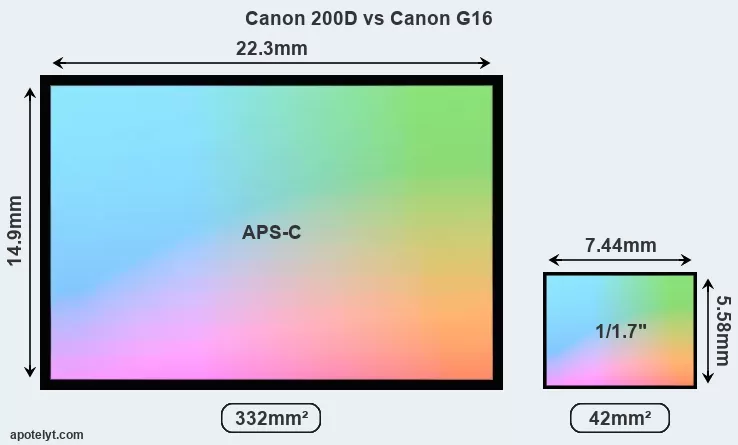
With 24MP, the 200D offers a higher resolution than the G16 (12MP), but the 200D nevertheless has larger individual pixels (pixel pitch of 3.72μm versus 1.87μm for the G16) due to its larger sensor. Moreover, the 200D is a much more recent model (by 3 years and 10 months) than the G16, and its sensor will have benefitted from technological advances during this time that further enhance the light gathering capacity of its pixels.
The resolution advantage of the Canon 200D implies greater flexibility for cropping images or the possibility to print larger pictures. The maximum print size of the 200D for good quality output (200 dots per inch) amounts to 30 x 20 inches or 76.2 x 50.8 cm, for very good quality (250 dpi) 24 x 16 inches or 61 x 40.6 cm, and for excellent quality (300 dpi) 20 x 13.3 inches or 50.8 x 33.9 cm. The corresponding values for the Canon G16 are 20 x 15 inches or 50.8 x 38.1 cm for good quality, 16 x 12 inches or 40.6 x 30.5 cm for very good quality, and 13.3 x 10 inches or 33.9 x 25.4 cm for excellent quality prints.
The 200D has on-sensor phase detect pixels, which results in fast and reliable autofocus acquisition even during live view operation.
The Canon EOS 200D has a native sensitivity range from ISO 100 to ISO 25600, which can be extended to ISO 100-51200. The corresponding ISO settings for the Canon PowerShot G16 are ISO 80 to ISO 12800 (no boost).
In terms of underlying technology, the 200D is build around a CMOS sensor, while the G16 uses a BSI-CMOS imager. Both cameras use a Bayer filter for capturing RGB colors on a square grid of photosensors. This arrangement is found in most digital cameras.
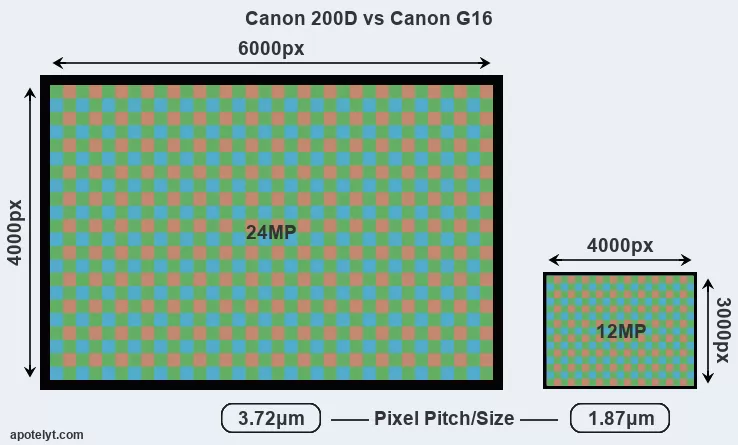
For many cameras, data on sensor performance has been reported by DXO Mark. This service is based on lab testing and assigns an overall score to each camera sensor, as well as ratings for dynamic range ("DXO Landscape"), color depth ("DXO Portrait"), and low-light sensitivity ("DXO Sports"). Of the two cameras under review, the 200D provides substantially higher image quality than the G16, with an overall score that is 25 points higher. This advantage is based on 2.6 bits higher color depth, 1.7 EV in additional dynamic range, and 2.2 stops in additional low light sensitivity. The table below summarizes the physical sensor characteristics and sensor quality findings and compares them across a set of similar cameras.

| Camera Model |
Sensor Class |
Resolution (MP) |
Horiz. Pixels |
Vert. Pixels |
Video Format |
DXO Portrait |
DXO Landscape |
DXO Sports |
DXO Overall |
||
|---|---|---|---|---|---|---|---|---|---|---|---|
| 1. | Canon 200D | APS-C | 24.0 | 6000 | 4000 | 1080/60p | 23.6 | 13.4 | 1041 | 79 | |
| 2. | Canon G16 | 1/1.7 | 12.0 | 4000 | 3000 | 1080/60p | 21.0 | 11.7 | 230 | 54 | |
| 3. | Canon 77D | APS-C | 24.0 | 6000 | 4000 | 1080/60p | 23.6 | 13.3 | 971 | 78 | |
| 4. | Canon 100D | APS-C | 17.9 | 5184 | 3456 | 1080/30p | 21.8 | 11.3 | 843 | 63 | |
| 5. | Canon 250D | APS-C | 24.0 | 6000 | 4000 | 4K/25p | 23.9 | 13.4 | 1791 | 82 | |
| 6. | Canon 760D | APS-C | 24.0 | 6000 | 4000 | 1080/30p | 22.6 | 12.0 | 915 | 70 | |
| 7. | Canon 800D | APS-C | 24.0 | 6000 | 4000 | 1080/60p | 23.7 | 13.1 | 1586 | 80 | |
| 8. | Canon 2000D | APS-C | 24.0 | 6000 | 4000 | 1080/30p | 22.6 | 11.9 | 1009 | 71 | |
| 9. | Canon G9 X Mark II | 1-inch | 20.0 | 5472 | 3648 | 1080/60p | 21.9 | 12.5 | 522 | 65 | |
| 10. | Canon G12 | 1/1.7 | 10.0 | 3648 | 2736 | 720/24p | 20.4 | 11.2 | 161 | 47 | |
| 11. | Canon G15 | 1/1.7 | 12.0 | 4000 | 3000 | 1080/24p | 19.9 | 11.5 | 165 | 46 | |
| 12. | Canon M5 | APS-C | 24.0 | 6000 | 4000 | 1080/60p | 23.4 | 12.4 | 1262 | 77 | |
| 13. | Canon M100 | APS-C | 24.0 | 6000 | 4000 | 1080/60p | 23.5 | 12.9 | 1272 | 78 | |
| 14. | Canon SL1 | APS-C | 17.9 | 5184 | 3456 | 1080/30p | 21.8 | 11.3 | 843 | 63 | |
| 15. | Nikon D3400 | APS-C | 24.0 | 6000 | 4000 | 1080/60p | 24.8 | 13.9 | 1192 | 86 | |
| 16. | Nikon P7800 | 1/1.7 | 12.0 | 4000 | 3000 | 1080/30p | 21.2 | 11.7 | 200 | 54 | |
| 17. | Panasonic LX7 | 1/1.7 | 10.0 | 3648 | 2736 | 1080/60p | 20.7 | 11.7 | 147 | 50 | |
| Note: DXO values in italics represent estimates based on sensor size and age. | |||||||||||
Many modern cameras are not only capable of taking still images, but can also record movies. Both cameras under consideration have a sensor with sufficiently fast read-out times for moving pictures, and both provide the same movie specifications (1080/60p).
Feature comparison
Apart from body and sensor, cameras can and do differ across a range of features. The 200D and the G16 are similar in the sense that both have an optical viewfinder. The latter is useful for getting a clear image for framing even in brightly lit environments. The table below summarizes some of the other core capabilities of the Canon 200D and Canon G16 in connection with corresponding information for a sample of similar cameras.

| Camera Model |
Viewfinder (Type or 000 dots) |
Control Panel (yes/no) |
LCD Specifications (inch/000 dots) |
LCD Attach- ment |
Touch Screen (yes/no) |
Max Shutter Speed * |
Max Shutter Flaps * |
Built-in Flash (yes/no) |
Built-in Image Stab |
||
|---|---|---|---|---|---|---|---|---|---|---|---|
| 1. | Canon 200D | optical | n | 3.0 / 1040 | swivel | Y | 1/4000s | 5.0/s | Y | n | |
| 2. | Canon G16 | optical | n | 3.0 / 922 | fixed | n | 1/4000s | 2.2/s | Y | Y | |
| 3. | Canon 77D | optical | Y | 3.0 / 1040 | swivel | Y | 1/4000s | 6.0/s | Y | n | |
| 4. | Canon 100D | optical | n | 3.0 / 1040 | fixed | Y | 1/4000s | 4.9/s | Y | n | |
| 5. | Canon 250D | optical | n | 3.0 / 1040 | swivel | Y | 1/4000s | 5.0/s | Y | n | |
| 6. | Canon 760D | optical | Y | 3.0 / 1040 | swivel | Y | 1/4000s | 5.0/s | Y | n | |
| 7. | Canon 800D | optical | n | 3.0 / 1040 | swivel | Y | 1/4000s | 6.0/s | Y | n | |
| 8. | Canon 2000D | optical | n | 3.0 / 920 | fixed | n | 1/4000s | 3.0/s | Y | n | |
| 9. | Canon G9 X Mark II | none | n | 3.0 / 1040 | fixed | Y | 1/2000s | 8.2/s | Y | Y | |
| 10. | Canon G12 | optical | n | 2.8 / 461 | swivel | n | 1/4000s | 1.1/s | Y | Y | |
| 11. | Canon G15 | optical | n | 3.0 / 922 | fixed | n | 1/4000s | 2.1/s | Y | Y | |
| 12. | Canon M5 | 2360 | n | 3.2 / 1620 | tilting | Y | 1/4000s | 9.0/s | Y | n | |
| 13. | Canon M100 | none | n | 3.0 / 1040 | tilting | Y | 1/4000s | 6.1/s | Y | n | |
| 14. | Canon SL1 | optical | n | 3.0 / 1040 | fixed | Y | 1/4000s | 4.9/s | Y | n | |
| 15. | Nikon D3400 | optical | n | 3.0 / 921 | fixed | n | 1/4000s | 5.0/s | Y | n | |
| 16. | Nikon P7800 | 921 | n | 3.0 / 921 | swivel | n | 1/4000s | 8.0/s | Y | Y | |
| 17. | Panasonic LX7 | optional | n | 3.0 / 920 | fixed | n | 1/4000s | 11.0/s | Y | Y | |
| Note: *) Information refers to the mechanical shutter, unless the camera only has an electronic one. | |||||||||||
One differentiating feature between the two cameras concerns the touch sensitivity of the rear screen. The 200D has a touchscreen, while the G16 has a conventional panel. Touch control can be particularly helpful, for example, for setting the focus point.
The 200D has an articulated LCD that can be turned to be front-facing. This characteristic will be appreciated by vloggers and photographers who are interested in snapping selfies. In contrast, the G16 does not have a selfie-screen.The Canon G16 has an intervalometer built-in. This enables the photographer to capture time lapse sequences, such as flower blooming, a sunset or moon rise, without purchasing an external camera trigger and related software.
Concerning the storage of imaging data, both the 200D and the G16 write their files to SDXC cards. Both cameras can use UHS-I cards, which provide for Ultra High Speed data transfer of up to 104 MB/s.
Connectivity comparison
For some imaging applications, the extent to which a camera can communicate with its environment can be an important aspect in the camera decision process. The table below provides an overview of the connectivity of the Canon EOS 200D and Canon PowerShot G16 and, in particular, the interfaces the cameras (and selected comparators) provide for accessory control and data transfer.

| Camera Model |
Hotshoe Port |
Internal Mic / Speaker |
Microphone Port |
Headphone Port |
HDMI Port |
USB Port |
WiFi Support |
NFC Support |
Bluetooth Support |
||
|---|---|---|---|---|---|---|---|---|---|---|---|
| 1. | Canon 200D | Y | stereo / mono | Y | - | mini | 2.0 | Y | Y | Y | |
| 2. | Canon G16 | Y | stereo / mono | - | - | mini | 2.0 | Y | - | - | |
| 3. | Canon 77D | Y | stereo / mono | Y | - | mini | 2.0 | Y | Y | Y | |
| 4. | Canon 100D | Y | mono / mono | Y | - | mini | 2.0 | - | - | - | |
| 5. | Canon 250D | Y | stereo / mono | Y | - | mini | 2.0 | Y | - | Y | |
| 6. | Canon 760D | Y | stereo / mono | Y | - | mini | 2.0 | Y | Y | - | |
| 7. | Canon 800D | Y | stereo / mono | Y | - | mini | 2.0 | Y | Y | Y | |
| 8. | Canon 2000D | Y | mono / mono | - | - | mini | 2.0 | Y | Y | - | |
| 9. | Canon G9 X Mark II | - | stereo / mono | - | - | micro | 2.0 | Y | Y | Y | |
| 10. | Canon G12 | Y | stereo / mono | - | - | mini | 2.0 | - | - | - | |
| 11. | Canon G15 | Y | stereo / mono | - | - | mini | 2.0 | - | - | - | |
| 12. | Canon M5 | Y | stereo / mono | Y | - | mini | 2.0 | Y | Y | Y | |
| 13. | Canon M100 | - | stereo / mono | - | - | micro | 2.0 | Y | Y | Y | |
| 14. | Canon SL1 | Y | mono / mono | Y | - | mini | 2.0 | - | - | - | |
| 15. | Nikon D3400 | Y | mono / mono | - | - | mini | 2.0 | - | - | Y | |
| 16. | Nikon P7800 | Y | stereo / mono | Y | - | mini | 2.0 | - | - | - | |
| 17. | Panasonic LX7 | Y | stereo / mono | - | - | mini | 2.0 | - | - | - |
It is notable that the 200D has a microphone port, which is missing on the G16. Such an external microphone input can help to substantially improve the quality of audio recordings when a good external microphone is used.
Both the 200D and the G16 have been discontinued, but can regularly be found used on ebay. The 200D was replaced by the Canon 250D, while the G16 does not have a direct successor. Further information on the features and operation of the 200D and G16 can be found, respectively, in the Canon 200D Manual (free pdf) or the online Canon G16 Manual.
Review summary
So what is the bottom line? Is there a clear favorite between the Canon 200D and the Canon G16? Which camera is better? Below is a summary of the relative strengths of each of the two contestants.
Reasons to prefer the Canon EOS 200D:
- More detail: Offers more megapixels (24 vs 12MP) with a 44% higher linear resolution.
- Better image quality: Scores substantially higher (25 points) in the DXO overall assessment.
- Richer colors: Generates images with noticeably better colors (2.6 bits more color depth).
- More dynamic range: Captures a larger spectrum of light and dark details (1.7 EV of extra DR).
- Better low-light sensitivity: Requires less light for good images (2.2 stops ISO advantage).
- Better jpgs: Has a more modern image processing engine (DIGIC 7 vs DIGIC 6).
- Better live-view autofocus: Features on-sensor phase-detection for more confident autofocus.
- Better sound: Can connect to an external microphone for higher quality sound recording.
- More detailed LCD: Has a higher resolution rear screen (1040k vs 922k dots).
- More flexible LCD: Has a swivel screen for odd-angle shots in portrait or landscape orientation.
- Fewer buttons to press: Is equipped with a touch-sensitive rear screen to facilitate handling.
- More selfie-friendly: Has an articulated screen that can be turned to be front-facing.
- Faster burst: Shoots at higher frequency (5 vs 2.2 flaps/sec) to capture the decisive moment.
- More flexible: Can take a variety of interchangeable lenses, including specialty optics.
- Longer lasting: Can take more shots (650 versus 360) on a single battery charge.
- Easier device pairing: Supports NFC for fast wireless image transfer over short distances.
- Easier wireless transfer: Supports Bluetooth for image sharing without cables.
- More modern: Reflects 3 years and 10 months of technical progress since the G16 launch.
Advantages of the Canon PowerShot G16:
- Easier time-lapse photography: Has an intervalometer built-in for low frequency shooting.
- Ready to shoot: Comes with an integrated lens, while the 200D requires a separate lens.
- More compact: Is smaller (109x76mm vs 122x93mm) and will fit more readily into a bag.
- Less heavy: Has a lower weight even though it has a lens built in (unlike the 200D).
- Sharper images: Has stabilization technology built-in to reduce the impact of hand-shake.
- More heavily discounted: Has been around for much longer (launched in August 2013).
If the count of relative strengths (bullet points above) is taken as a measure, the 200D is the clear winner of the match-up (18 : 6 points). However, the relevance of individual strengths will vary across photographers, so that you might want to apply your own weighing scheme to the summary points when reflecting and deciding on a new camera. A professional wildlife photographer will view the differences between cameras in a way that diverges from the perspective of a family photog, and a person interested in architecture has distinct needs from a sports shooter. Hence, the decision which camera is best and worth buying is often a very personal one.
How about other alternatives? Do the specifications of the Canon 200D and the Canon G16 place the cameras among the top in their class? Find out in the latest Best DSLR Camera and Best Travel-Zoom Camera listings whether the two cameras rank among the cream of the crop.
In any case, while the comparison of the spec-sheets of cameras can offer a general idea of their imaging potential, it says little about, for example, the shooting experience and imaging performance of the 200D and the G16 in practical situations. User reviews that are available, for instance, at amazon can sometimes shed light on these issues, but such feedback is all too often partial, inconsistent, and inaccurate.
Expert reviews
This is why hands-on reviews by experts are important. The following table reports the overall ratings of the cameras as published by some of the major camera review sites (amateurphotographer [AP], cameralabs [CL], digitalcameraworld [DCW], dpreview [DPR], ephotozine [EPZ], photographyblog [PB]). As can be seen, the professional reviewers agree in many cases on the quality of different cameras, but sometimes their assessments diverge, reinforcing the earlier point that a camera decision is often a very personal choice.

| Camera Model |
AP score |
CL score |
DCW score |
DPR score |
EPZ score |
PB score |
Camera Launch |
Launch Price |
Street Price |
||
|---|---|---|---|---|---|---|---|---|---|---|---|
| 1. | Canon 200D | 4/5 | + + | 4/5 | 78/100 | 4.5/5 | 4.5/5 | Jun 2017 | US$ 549 | ebay.com | |
| 2. | Canon G16 | 4/5 | + | .. | .. | 4.5/5 | 4.5/5 | Aug 2013 | US$ 549 | ebay.com | |
| 3. | Canon 77D | 4.5/5 | .. | 4/5 | 82/100 | 4.5/5 | 4/5 | Feb 2017 | US$ 899 | ebay.com | |
| 4. | Canon 100D | 4/5 | + | .. | 78/100 | 4/5 | 4/5 | Mar 2013 | US$ 549 | ebay.com | |
| 5. | Canon 250D | 4/5 | o | 4.5/5 | 79/100 | 4/5 | 4/5 | Apr 2019 | US$ 599 | amazon.com | |
| 6. | Canon 760D | 5/5 | + | .. | 77/100 | 4.5/5 | 4.5/5 | Feb 2015 | US$ 649 | ebay.com | |
| 7. | Canon 800D | 4.5/5 | .. | 3.5/5 | 80/100 | 4.5/5 | 4/5 | Feb 2017 | US$ 749 | ebay.com | |
| 8. | Canon 2000D | 3/5 | o | 3.5/5 | .. | 3.5/5 | 3.5/5 | Feb 2018 | US$ 449 | amazon.com | |
| 9. | Canon G9 X Mark II | 4/5 | .. | 4/5 | 75/100 | 4.5/5 | 4.5/5 | Jan 2017 | US$ 529 | ebay.com | |
| 10. | Canon G12 | 4/5 | + | .. | 73/100 | 4.5/5 | 4.5/5 | Sep 2010 | US$ 499 | ebay.com | |
| 11. | Canon G15 | 4/5 | + | .. | 76/100 | 4.5/5 | 4.5/5 | Sep 2012 | US$ 499 | ebay.com | |
| 12. | Canon M5 | 4/5 | + | 4/5 | 82/100 | 4/5 | 4/5 | Sep 2016 | US$ 979 | ebay.com | |
| 13. | Canon M100 | 3/5 | + | .. | .. | 4/5 | 3.5/5 | Aug 2017 | US$ 499 | ebay.com | |
| 14. | Canon SL1 | 4/5 | + | .. | 78/100 | 4/5 | 4/5 | Mar 2013 | US$ 549 | ebay.com | |
| 15. | Nikon D3400 | 4/5 | + | 4/5 | 76/100 | 4/5 | 4.5/5 | Aug 2016 | US$ 499 | ebay.com | |
| 16. | Nikon P7800 | 3/5 | .. | .. | .. | 4/5 | 4.5/5 | Sep 2013 | US$ 549 | ebay.com | |
| 17. | Panasonic LX7 | 3/5 | + + | .. | 75/100 | 4/5 | 4.5/5 | Jul 2012 | US$ 499 | ebay.com | |
| Note: (+ +) highly recommended; (+) recommended; (o) reviewed; (..) not available. | |||||||||||
Care should be taken when interpreting the review scores above, though. The ratings were established in reference to similarly priced cameras that were available in the market at the time of the review. Thus, a score needs to be put into the context of the launch date and the launch price of the camera, and rating-comparisons among cameras that span long time periods or concern very differently equipped models make little sense. Also, kindly note that some of the listed sites have over time developped their review approaches and their reporting style.

Check 200D offers at
ebay.com

Check G16 offers at
ebay.com
Other camera comparisons
Did this review help to inform your camera decision process? In case you are interested in seeing how other cameras pair up, just make your choice using the following search menu. As an alternative, you can also directly jump to any one of the listed comparisons that were previously generated by the CAM-parator tool.
- Canon 1D X Mark II vs Canon G16
- Canon 200D vs Canon 7D II
- Canon 200D vs Canon M50 Mark II
- Canon 200D vs Fujifilm GFX 100 II
- Canon 200D vs Fujifilm XF10
- Canon 200D vs Olympus E-M5 III
- Canon 200D vs Sony NEX-5T
- Canon G16 vs Fujifilm X-E1
- Canon G16 vs Fujifilm XP130
- Canon G16 vs Olympus E-PL6
- Canon G16 vs Sony A1
- Canon G16 vs Sony A900
Specifications: Canon 200D vs Canon G16
Below is a side-by-side comparison of the specs of the two cameras to facilitate a quick review of their differences and common features.
| Camera Model | Canon 200D | Canon G16 |
|---|---|---|
| Camera Type | Digital single lens reflex | Fixed lens compact camera |
| Camera Lens | Canon EF mount lenses | 28-140mm f/1.8-2.8 |
| Launch Date | June 2017 | August 2013 |
| Launch Price | USD 549 | USD 549 |
| Sensor Specs | Canon 200D | Canon G16 |
| Sensor Technology | CMOS | BSI-CMOS |
| Sensor Format | APS-C Sensor | 1/1.7" Sensor |
| Sensor Size | 22.3 x 14.9 mm | 7.44 x 5.58 mm |
| Sensor Area | 332.27 mm2 | 41.5152 mm2 |
| Sensor Diagonal | 26.8 mm | 9.3 mm |
| Crop Factor | 1.6x | 4.65x |
| Sensor Resolution | 24 Megapixels | 12 Megapixels |
| Image Resolution | 6000 x 4000 pixels | 4000 x 3000 pixels |
| Pixel Pitch | 3.72 μm | 1.87 μm |
| Pixel Density | 7.22 MP/cm2 | 28.91 MP/cm2 |
| Moiré control | Anti-Alias filter | Anti-Alias filter |
| Movie Capability | 1080/60p Video | 1080/60p Video |
| ISO Setting | 100 - 25,600 ISO | 80 - 12,800 ISO |
| ISO Boost | 100 - 51,200 ISO | no Enhancement |
| Image Processor | DIGIC 7 | DIGIC 6 |
| DXO Sensor Quality (score) | 79 | 54 |
| DXO Color Depth (bits) | 23.6 | 21.0 |
| DXO Dynamic Range (EV) | 13.4 | 11.7 |
| DXO Low Light (ISO) | 1041 | 230 |
| Screen Specs | Canon 200D | Canon G16 |
| Viewfinder Type | Optical viewfinder | Optical viewfinder |
| Viewfinder Field of View | 95% | 80% |
| Viewfinder Magnification | 0.54x | |
| LCD Framing | Live View | Live View |
| Rear LCD Size | 3.0inch | 3.0inch |
| LCD Resolution | 1040k dots | 922k dots |
| LCD Attachment | Swivel screen | Fixed screen |
| Touch Input | Touchscreen | no Touchscreen |
| Shooting Specs | Canon 200D | Canon G16 |
| Focus System | Phase-detect AF | Contrast-detect AF |
| Manual Focusing Aid | no Peaking Feature | Focus Peaking |
| Max Shutter Speed (mechanical) | 1/4000s | 1/4000s |
| Continuous Shooting | 5 shutter flaps/s | 2.2 shutter flaps/s |
| Time-Lapse Photography | no Intervalometer | Intervalometer built-in |
| Fill Flash | Built-in Flash | Built-in Flash |
| Storage Medium | SDXC cards | SDXC cards |
| Single or Dual Card Slots | Single card slot | Single card slot |
| UHS card support | UHS-I | UHS-I |
| Connectivity Specs | Canon 200D | Canon G16 |
| External Flash | Hotshoe | Hotshoe |
| USB Connector | USB 2.0 | USB 2.0 |
| HDMI Port | mini HDMI | mini HDMI |
| Microphone Port | External MIC port | no MIC socket |
| Wifi Support | Wifi built-in | Wifi built-in |
| Near-Field Communication | NFC built-in | no NFC |
| Bluetooth Support | Bluetooth built-in | no Bluetooth |
| Body Specs | Canon 200D | Canon G16 |
| Battery Type | Canon LP-E17 | Canon NB-10L |
| Battery Life (CIPA) | 650 shots per charge | 360 shots per charge |
| Body Dimensions |
122 x 93 x 70 mm (4.8 x 3.7 x 2.8 in) |
109 x 76 x 40 mm (4.3 x 3.0 x 1.6 in) |
| Camera Weight | 453 g (16.0 oz) | 356 g (12.6 oz) |

Check 200D offers at
ebay.com

Check G16 offers at
ebay.com
Did you notice an error on this page? If so, please get in touch, so that we can correct the information.
